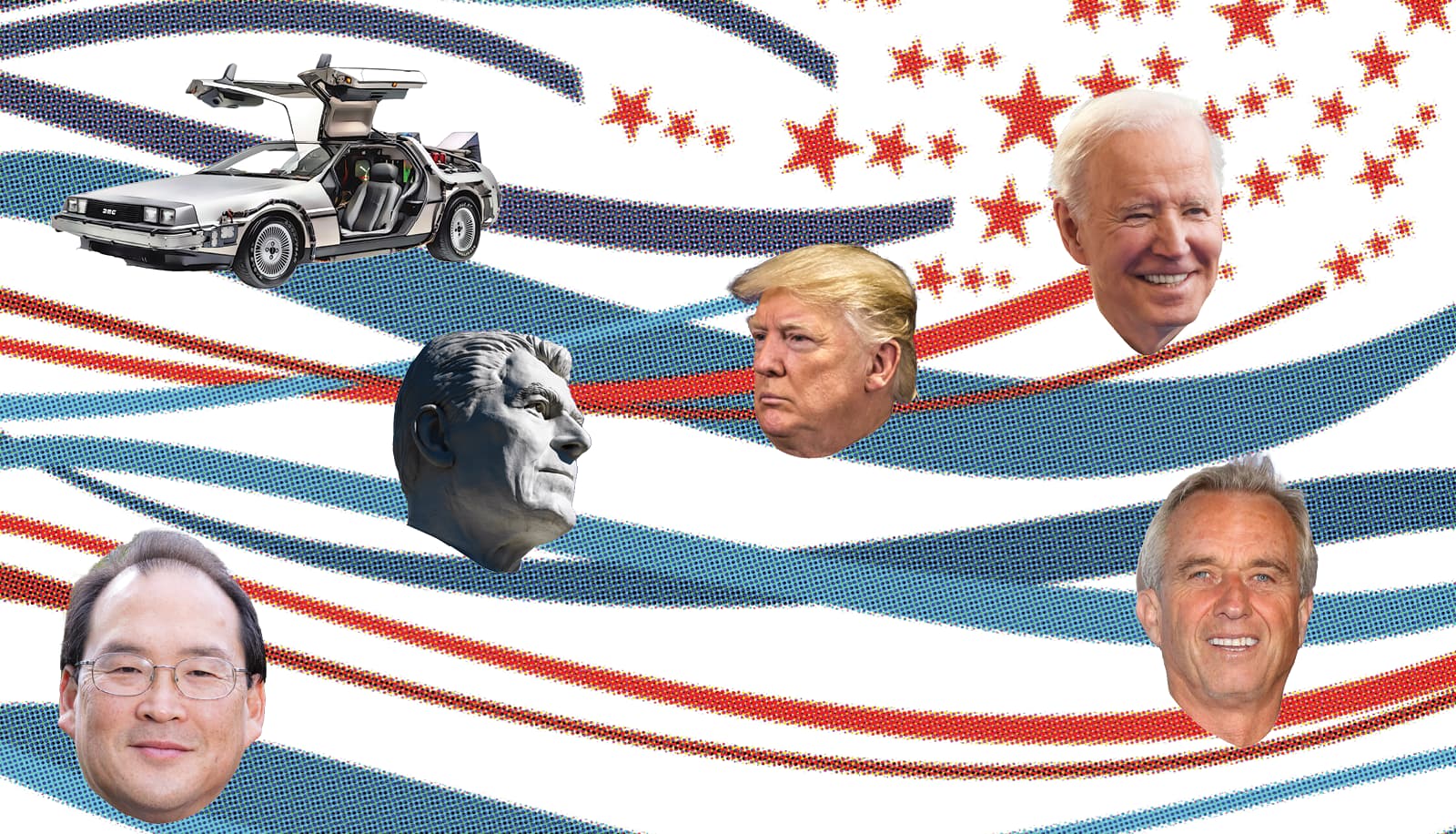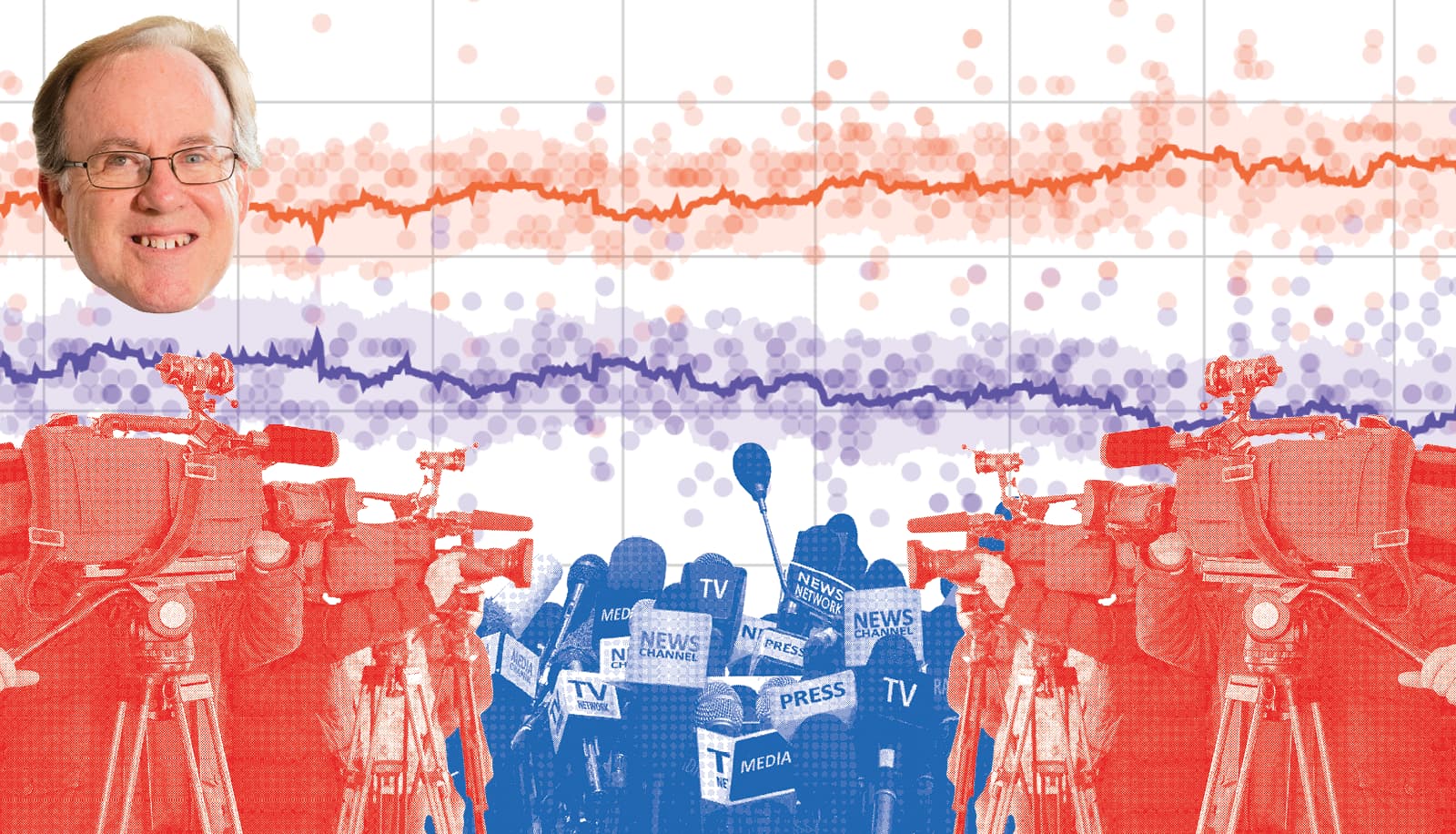
Presidential Election 2024
Professors John Baick and Tim Vercellotti Weigh In

Part 1: Baick to the Future with WNE History Professor John Baick
Question 1: The title grabbed you, didn’t it?
For those of you who had me as a professor, the title should remind you how to pronounce my name (sounds like “back”). It’s also a reference to a cult classic that can be a useful way of thinking about our current political climate. If we consider the film, we have a new way to understand how voters might be thinking about the future — specifically, the 2024 election.
Question 2: Do you remember the plot of Back to the Future?
The movie features Marty McFly, a suburban high schooler in 1985 who travels 30 years back in time and then needs to return home to his own era — hence “back” to the future in the title. During his adventures in 1955, Marty encounters his father and mother as teenagers. He helps his father overcome a bully, find his voice, and fall in love with his mom. In the process, Marty inadvertently changes the future of 1985.
Question 3: Did you know the slogan “Make America Great Again” was plagiarized?
Long before Trump donned a “MAGA” hat, Ronald Reagan ran for president in 1980 with the slogan “Let’s Make America Great Again.” Ultimately, Reagan’s slogan and the 1985 movie Back to the Future were both successful for the same reason: 1980s America was full of both doubts about the present and nostalgia for the past, specifically the 1950s. Reagan wanted to return to this idealized past — and so, in his way, does Trump.
Why did America miss the 1950s? Let’s consider the film the way Donald Trump would. When Marty traveled 30 years back in time, he found that his dingy 1985 hometown looked nicer. Families lived in new houses, ate together around the dinner table, drove new cars, and enjoyed full service at the gas station. Everyone knew their place in society, saw the same movies, sang the same songs, and watched the same TV shows. There was no visible crime or poverty, and the closest thing to protest was disappointed students at a dance. Things were simpler.
Question 4: Did you know that Joe Biden isn’t very exciting?
Joe Biden never had a slogan that caught on. In 2020, the Biden campaign tried “Restore the Soul of America” and “Build Back Better,” but they never resonated like “Make America Great Again.” That’s because Biden’s message is more complicated. He sees the past as filled with good things, but also things that can be improved.
The Joe Biden version of watching Back to the Future means appreciating many of the same charms that Trump, Reagan, and millions of viewers enjoyed about the 1950s while still addressing issues that need to be fixed. Marty’s dad was bullied — who else was being bullied in town, and why? Why was there only one Black person in town? What was it like to be a young woman in the 1950s? In the film, Marty’s mother was a damsel in distress who faced sexual assault, but she lacked an inner life or aspirations of her own beyond what was expected of a 1950s woman. She wasn’t quite a Barbie doll, but she wasn’t a full-fledged individual, either. She was just a trophy for men to fight over. The 1950s were great for some, but what about those who were left out?
Question 5: How do we remember the past?
The 2024 election will determine America’s future, but it will be based on how we remember the past. History is not just about what happened in the past — it’s about what we think of it. If you watch Back to the Future and want to hop in a time machine yourself, you’re probably a Trump voter. If you notice the ways that our past wasn’t perfect, you might resonate with Biden. And if your favorite part of the movie is when, around the dinner table, Marty mentions “John F. Kennedy,” you might understand why so many people are interested in voting for Robert F. Kennedy, Jr. Nostalgia is a powerful, powerful force. Stay tuned for the summer nominating conventions. The new slogans will be about, on some level, going “back” to the future.
Comments? Desire a follow-up conversation? Contact me at jbaick@wne.edu.

Part 2: Obsessed with election polls? Tips to survive the 2024 presidential contest with WNE Political Science Professor Tim Vercellotti
Thousands of national and state political polls came out during the 2020 presidential election year, and thousands more will make their way into the public consciousness in the upcoming 2024 election cycle.
While political poll results can evoke frustration, panic, or euphoria among political observers, surveys also feed an insatiable audience. No sooner is a poll out than we start looking for the next release of findings, either to confirm or dispute the trends that we see. The shelf life of any one survey is remarkably brief, despite the careful work that goes into designing and executing a valid and reliable poll.
Those of us who observe politics for a living, as an avocation, or simply as informed voters, can easily forget that each poll is a snapshot in time. Surveys do not predict the future, but they can give us a broad sense of where a political contest stands at a given point in the campaign. Having your spirits rise or fall based on any single set of results can make for a long and exhausting slog to Election Day.
If following political polls is second nature to you, here are some pieces of advice to bear in mind as we make our way through the 2024 presidential campaign:
1. Retain healthy skepticism about presidential polls.
A task force convened by the American Association for Public Opinion Research (AAPOR), the leading professional organization for survey researchers in the U.S., found that national presidential polls in 2020 had a higher average error in their estimation of the popular vote than at any time in the previous 40 years. The average error for the presidential, gubernatorial, and U.S. Senate races in state-level polls was the highest it had been in 20 years. The errors tended to overstate Joe Biden’s share of the vote and understate Donald Trump’s. The outcome of the election reflected the overall trends of the polls, but Biden’s actual margin of victory in the popular vote was smaller than the pre-election polls had suggested.
This level of error occurred despite survey methodologists embracing key lessons from the 2016 cycle, including watching for late shifts in voter preferences and ensuring that samples were weighted to accurately reflect the makeup of the electorate in terms of education. The AAPOR task force, made up of some of the polling industry’s most respected experts, indicated that the 2020 polls had addressed those issues as well as other concerns (such as the high rate of early voting and voting by mail due to the COVID-19 pandemic). Without the ability to interview individuals who had not responded to the surveys, it was difficult to pinpoint precise sources of the 2020 errors.
With that in mind, should we ignore the 2024 polls? That would be a mistake, given that we can still learn a lot about the dynamics of the campaign even if we cannot be certain of the potential outcome. We can still look at the broad brushstrokes that polling can provide, such as the issues that may be driving turnout and the candidate qualities that voters value most. That data can give us a feel for the state of the contest, even if we lack the precision that we would like to have when it comes to the horse race.
2. All polls are not created equal. Look at trends instead of specific surveys and monitor state-level surveys over national polls when doing your Electoral College math.
Even when survey researchers can draw a reliable probability sample and develop a realistic likely voter model, a single poll’s results can be an outlier. We are much better off looking at an aggregation of surveys, which can smooth out the impact of any one poll that might have surprising findings. Many websites provide up-to-date survey aggregations, including RealClearPolitics and FiveThirtyEight. Also, keep checking the aggregations over time. Any given week’s outlier results might be the leading edge of a shift in public opinion that the following week’s polls may capture and confirm.
And, while national surveys tend to get the headlines, remember that a presidential election consists of 50 state elections (and an election in the District of Columbia). With votes in the Electoral College awarded by each state and DC, the state-level surveys give us the most detailed look at the race.
Even at the state level, we can narrow our focus to a handful of swing states (Arizona, Georgia, Michigan, Nevada, North Carolina, Pennsylvania, and Wisconsin) where the presidential election is expected to be decided. Each decision was made by fewer than three percentage points in the certified vote in 2020. Together, those states comprise 93 votes in the Electoral College, or more than a third of what a presidential candidate needs to get to the magic number of 270. Significant shifts in voter preferences in other states might expand that map between now and Election Day, but if you are looking for a quick assessment of the race, examining aggregations of surveys in each of these seven states will give you a snapshot of where things stand.
3. Look for transparency when assessing the validity of polls.
Continuing with the theme that not all polls are created equal, look for transparency when deciding whether to give credence to survey results. Does the poll specify the type of sample (probability or non-probability), sample size, respondents (all adults, registered voters, or likely voters), dates of data collection, mode of data collection (telephone, online, or a combination of approaches), and how the data were weighted to reflect the population under study? Does the organization that conducted the poll identify its sponsor and provide a copy of the questionnaire with the full text of the questions, in addition to the order in which they appeared or were asked? The availability of this information can help you to judge whether the results come from a credible source.
If these basic elements are not shared by the polling organization, it may be best to move on to the next survey. Survey researchers who adhere to best practices are usually eager to report this information. You can also look for the survey research “seal of approval” — membership in the Transparency Initiative of the AAPOR. Members of the initiative pledge to make public the basic methodological details of a survey when releasing the results. The Polling Institute at Western New England University has been a charter member of the Transparency Initiative since 2015.
Keeping in mind these caveats may help as we sort through the stream of survey results that will come in the next few months. Awareness of the strengths and limitations of political polls can help keep results in perspective while we learn valuable information about the dynamics of the campaign.


